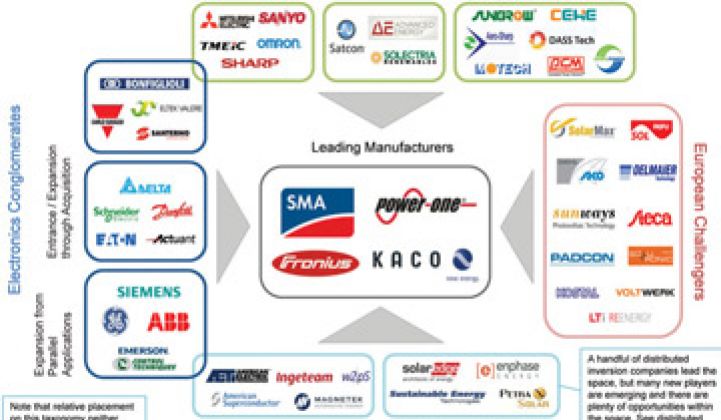See the full press release here.
The time is now for new solar PV inverter technologies. With inverter losses accounting for 59% of total PV project failure costs, developers, owners and financiers are beginning to focus on reliable and augmented power delivery as a key factor in improving the economics of their solar projects. This focus comes as global incentive programs begin to tighten and a new suite of next-gen inverters is offering improved power quality, unprecedented operability with the grid, and module-based products that are shifting the industry’s competitive trajectory.
At over 180 pages with more than 100 data-driven exhibits, GTM Research’s latest report, The Global PV Inverter Landscape: Technology and Market Trends, 2011-2015, covers the industry from end to end, exploring inverter technology developments for PV power delivery and profiling all the major suppliers. The report also dissects global shipments, which reached 21 GW in 2010, and presents the competitive dynamics that manufacturers will encounter as global PV demand decentralizes and regional supply influences inverter market shares.
“Advances in PV inverter technology promise to improve the commercial viability of solar power,” said GTM Research Analyst and report author MJ Shiao. “In larger systems, grid support features such as fault ride-through and reactive voltage support will make it more desirable for utilities and grid operators to integrate PV into the electric grid. With smaller-scale installations, micro-inverters and distributed power optimizers show potential to reduce installation costs and increase system performance.”
According to GTM Research, inverter manufacturers seeking to differentiate in a tightening global PV environment will drive new technology development. This group includes regional suppliers attempting to expand from their domestic base to establish a global footprint and large electrical equipment conglomerates prioritizing solar as a global growth opportunity.
“As the PV inverter industry expands out of traditional European strongholds, we will see stiff competition from regional players in emerging markets like North America and China,” said Shiao. “Establishing a combination of technology differentiation and bankability becomes a key pursuit for inverter manufacturers, especially for newcomers such as distributed optimization and micro-inverter companies, which saw shipments jump more than threefold in 2010, with the potential to reach 4.6 GW by 2015.”
FIGURE: Global PV Inverter Manufacturer Taxonomy
(Source: GTM Research)
While leading inverter incumbents SMA, Power-One, KACO New Energy, and Fronius currently account for over 61% of global PV inverter shipments, GTM Research sees an expansion of global demand engendering a new guard of U.S.- and Asia-based manufacturers. Accordingly, EU-based inverter manufacturers will have to strategically diversify and obtain new supply opportunities in new markets in order to avoid stagnant growth rates.
For more in-depth coverage of The Global PV Inverter Landscape: Technology and Market Trends, 2011-2015, visit www.gtmresearch.com/report/the-global-pv-inverter-landscape.



